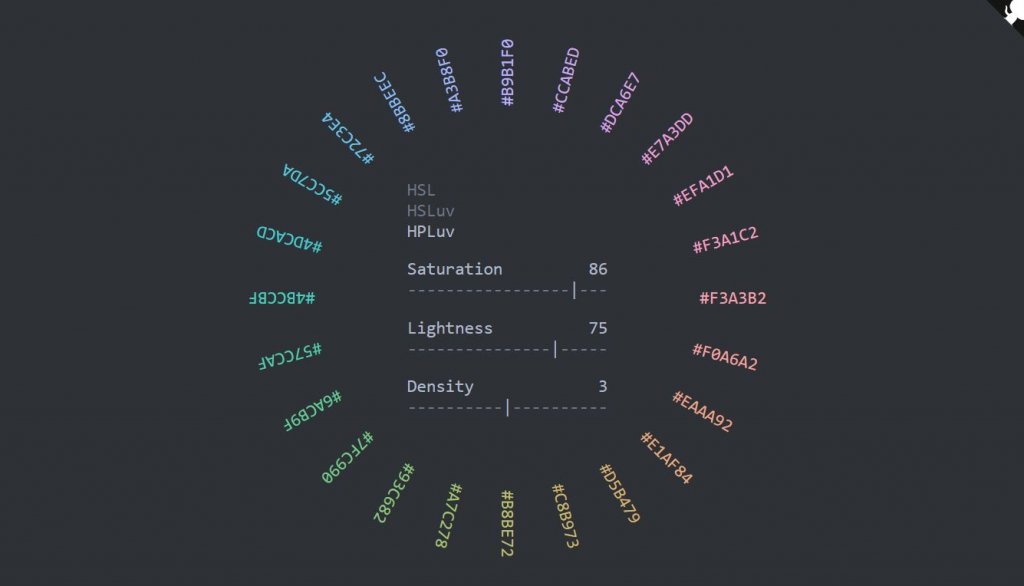

- #Html color palette from image generator
- #Html color palette from image code
- #Html color palette from image free
The following is an example of what to add between the preferences tags to add a categorical color palette. For example, when you put a discrete dimension such as Region on the Color card, the categorical color legend is used. Follow one of the next three procedures to create a custom color palette.Ī categorical color palette contains several distinct colors that can be assigned to discrete dimension members.Go to the My Tableau Repository folder in your Documents directory, and open the Preferences.tps file.īetween the opening and closing workbook tags, insert opening and closing preferences tags so that it looks like this: An unedited preferences file looks like this: The file is a basic XML file that you can open in a text editor to modify. The Preferences.tps file is located in your My Tableau Repository. Note: When you edit your Preferences.tps file, be sure to use straight quotation marks ( ' ' or " ") to delimit the palette name and type, not curly quotation marks (“ ” or ‘ ’). Also, there is no guarantee that custom color palettes you create will work with future Tableau Desktop upgrades. Tableau doesn't test or support custom color palettes, so be sure to back up your workbooks before you continue. You can use a new palette like you would any other. When you save the workbook and restart Tableau Desktop, the color palette names you added to Preferences.tps appear in the Select Color Palette drop-down list (Edit Color dialog). When you modify Preferences.tps to add colors, use the standard HTML format for the new colors (hexadecimal value #RRGGBB or Red Green Blue format). If you need to manually assign more than 20 colors to data items, you may want to create several custom palettes with 20 or fewer colors in each palette. Although there isn’t a limit to how many colors can be added to each custom palette, the Edit colors dialog box only shows 20 colors. You can add as many custom palettes as you like to your Preferences.tps file, each with as many colors as you want. For example, you can create a custom categorical palette that matches your company's brand. You can also create and use your own custom color palettes by modifying the Preferences.tps file that comes with Tableau Desktop.
#Html color palette from image generator
Each of these tools such as online image cropper and color shades generator is designed to solve a specific requirement and help developers, designers and tech professionals with their day-to-day tasks.Tableau Desktop comes with color palettes that have been carefully designed to work well together and effectively apply color to data in many situations, such as on maps, heatmaps, bar charts, etc.

#Html color palette from image free
Go to Color Converter MDiGi.tools – Free Web based Digital toolsĭo also explore mdigi.tools that houses free web-based micro digital tools that work inside your browser without the need of installing a software. This will take you to Color Converter, another nifty tool that will do the color format conversion and provide you with the color values in different formats.įor our image, I clicked on #EB75A6, the coral pink color and got the color codes in different color spaces: Color Codes in Different Formats – HEX, RGB, HSL & HSV
#Html color palette from image code
To copy a hex color code, just click on the color block and the color value will be copied to your clipboard. If you need the color code in any other format such as RGB or HSL, you can click on the corresponding HEX color code displayed below that color. Palette created out of dominant colors from the image Since everything is done inside the browser and no server side processing is required, the whole process is super fast. The tool instantaneously generated a color scheme from our image and displayed all the colors along with their HEX color codes as seen in the image below. For showing you how it works, I used an image of a pink daisy from Pixabay. The interface of Color Extractor is pretty simple, you just need to drag and drop your image. Color Palette from Image using Color Extractor Instead of using a color picker tool to grab each color individually from an image, you can now make an effective color combination in no time. Color Extractor supports all the popular image file formats including JPEG, PNG and GIF images. As its name suggests, this tool extracts the dominant colors from an image and creates a palette with nine colors. In this post, I will show how you can easily create a color palette from your inspirational photo using Color Extractor, a lightweight and fast browser-based tool developed by our team. More often than not you would come across an image with colors that you love, or hues that seem to go well together. Image sites such as Pixabay and Pinterest are a wonderful source for finding color inspiration for your projects. Choosing the right color scheme is important when creating impressive visual designs.


 0 kommentar(er)
0 kommentar(er)
